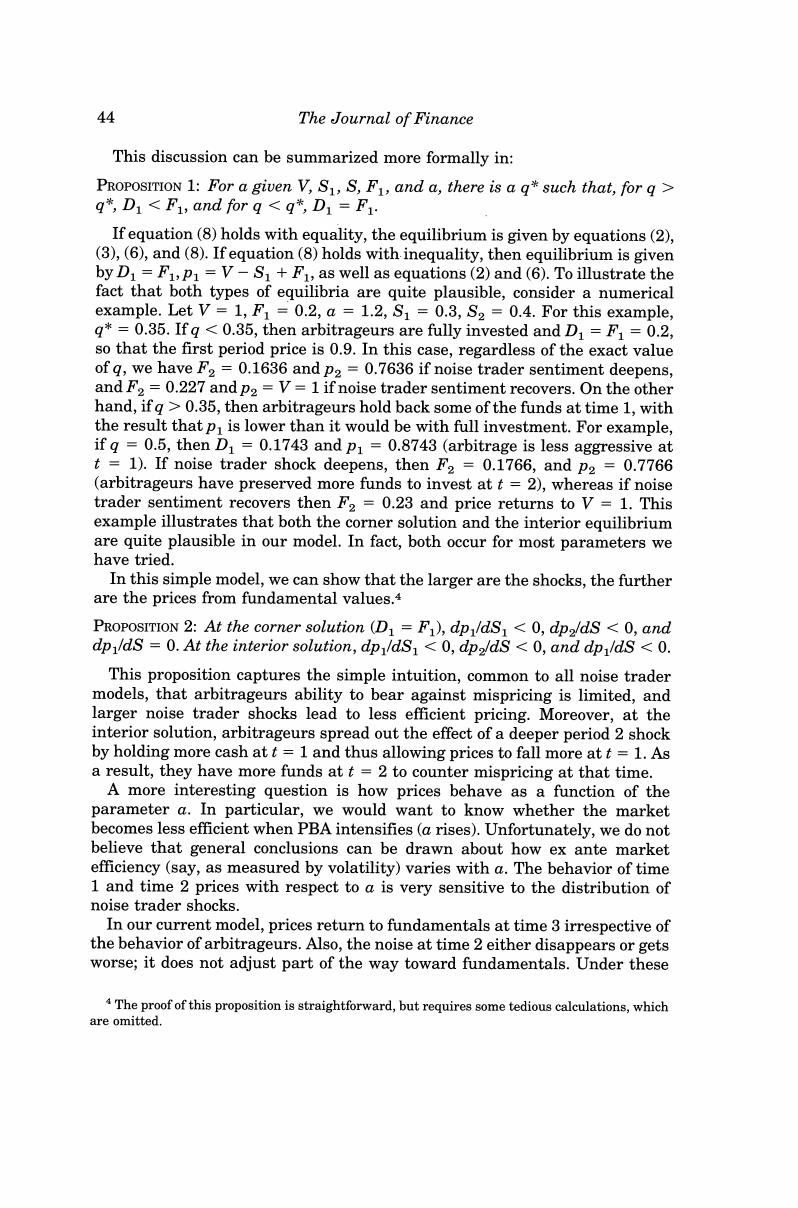正在加载图片...

44 The Journal of Finance This discussion can be summarized more formally in: PROPOSITION 1:For a given V,S1,S,F,and a,there is a q*such that,for q> q*,D1<F1,and for q<q*,D1=F1. If equation(8)holds with equality,the equilibrium is given by equations(2), (3),(6),and(8).Ifequation(8)holds with inequality,then equilibrium is given by D1=F1,P1=V-S1+F1,as well as equations(2)and (6).To illustrate the fact that both types of equilibria are quite plausible,consider a numerical example.Let V=1,F=0.2,a 1.2,S1=0.3,S2 =0.4.For this example, g*=0.35.If q <0.35,then arbitrageurs are fully invested and D=F=0.2, so that the first period price is 0.9.In this case,regardless of the exact value of g,we have F2=0.1636 and p2=0.7636 if noise trader sentiment deepens, and F2=0.227 and p2 =V=1 if noise trader sentiment recovers.On the other hand,if g >0.35,then arbitrageurs hold back some of the funds at time 1,with the result that p is lower than it would be with full investment.For example, if g=0.5,then D=0.1743 and p1=0.8743(arbitrage is less aggressive at t=1).If noise trader shock deepens,then F2=0.1766,and p2 0.7766 (arbitrageurs have preserved more funds to invest at t =2),whereas if noise trader sentiment recovers then F2=0.23 and price returns to V=1.This example illustrates that both the corner solution and the interior equilibrium are quite plausible in our model.In fact,both occur for most parameters we have tried. In this simple model,we can show that the larger are the shocks,the further are the prices from fundamental values.4 PROPOSITION 2:At the corner solution (D1=F),dp/ds<0,dp2/ds<0,and dplds =0.At the interior solution,dp/ds<0,dp2/ds<0,and dp/ds <0. This proposition captures the simple intuition,common to all noise trader models,that arbitrageurs ability to bear against mispricing is limited,and larger noise trader shocks lead to less efficient pricing.Moreover,at the interior solution,arbitrageurs spread out the effect of a deeper period 2 shock by holding more cash at t =1 and thus allowing prices to fall more at t =1.As a result,they have more funds at t=2 to counter mispricing at that time. A more interesting question is how prices behave as a function of the parameter a.In particular,we would want to know whether the market becomes less efficient when PBA intensifies(a rises).Unfortunately,we do not believe that general conclusions can be drawn about how ex ante market efficiency(say,as measured by volatility)varies with a.The behavior of time 1 and time 2 prices with respect to a is very sensitive to the distribution of noise trader shocks. In our current model,prices return to fundamentals at time 3 irrespective of the behavior of arbitrageurs.Also,the noise at time 2 either disappears or gets worse;it does not adjust part of the way toward fundamentals.Under these 4The proof of this proposition is straightforward,but requires some tedious calculations,which are omitted